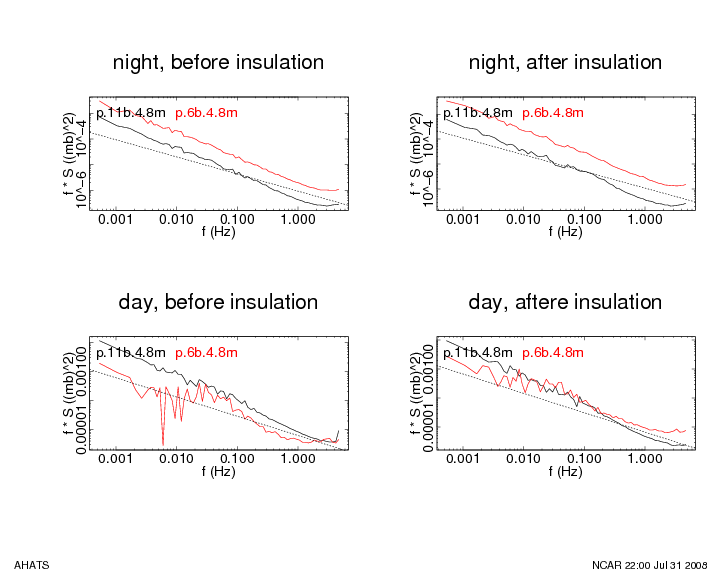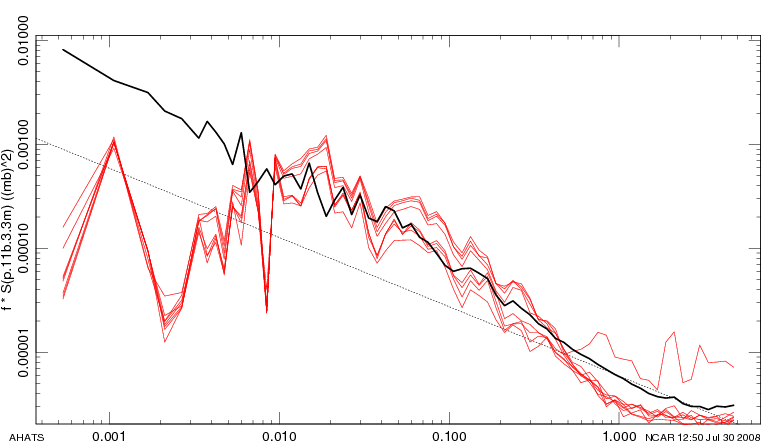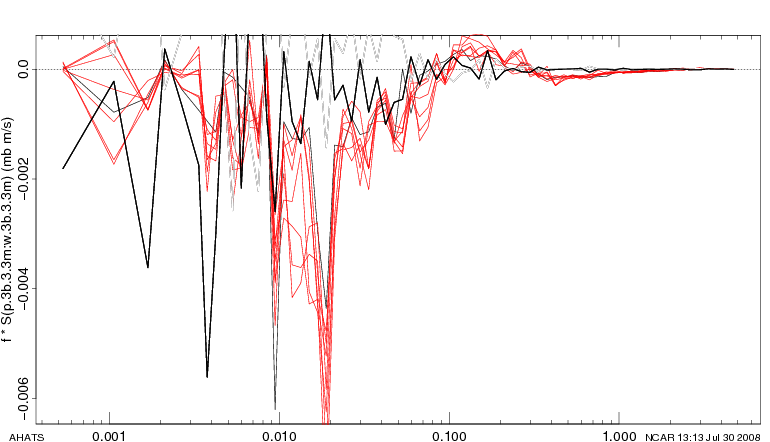I notice in the p' time series a drop of pressure at 1323 this afternoon. This looks like the signature of a dust devil to me (and I saw one earlier today near the trailer).
To further diagnose the p' system, I've been wanting to set up an independent system like CHATS. Now that John has brought out another pressure sensor, we made the following changes between 1030-1200:
- Installed the cal-lab field reference Paro 760 to measure Pref (in lieu of the 14th 202BG). Added it to profile:ttyS17 as P.0m.
- Changed the 14th 202BG (still known as p.11b.4.8m) to measure just like CHATS, between the Bedard port through the hose and the CHATS reference.
My initial look at the data show the signals 11b.4.8m and 6b.4.8m+P.0m to be roughly the same. I'll keep watching them.
I just shot angles for all sonics. I'll enter into the cal_files after lunch.
P.S. These are now entered (subtracting 131.7) and statsproc restarted.
Note0: that some of the times I entered as 29 jul and some as 31 jul, depending on when the sonic was last moved.
NOTE1: Sonic U5 s/n 712's upper arm was bent / misaligned with the lower claw when checked on 8/6/08. The value shown is for the lower arm alignment. jwm
Note2: On 8/6/08 beginning at 10:20PDT, JohnMilitzer, took a second set of readings as noted '2'. These were completed by 14:30PDT. In the middle of the afternoon, it was optically more difficult to see the alignment angle. I also took repeated readings and noticed some variance in those, but used the common value. The large difference between our readings is disturbing, although I verified that the data-scope still has a deviation setting of 0.0
Note3: On 8/7/08, SteveO and I returned to the site and tried once more, performing a calibration of the data-scope and doing a spot check. We noticed that the cell phones, as well as metal do cause errors on the scope. Before and after the cal, my spot check on U3 showed 137.2 vs 137.7 after cal. On the profile tower my post-cal readings for the lowest 3 were within .2.
Note4: Procedurally there are problems with the approach and our ability to hold the scope plumb on the camera tripod. Tilt-angle is extremely important and can introduce many degrees of error between level and ~20deg tilt for the 7 and 8m sonics. We can establish plumb optically using the verticle
RECOMMENDATION: reconsider putting a high quality electronic compass mounted under the theadolite on our surveyor's tripod instead of using the data-scope. That would allow us to setup a quick and reliable level, and eliminate the tilt-angle issue of the data-scope when looking aloft.
|
b |
b2 |
cal (b2) |
|
b-b2 |
|
t |
t2 |
cal (t2) |
|
t-t2 |
|
u |
u2 |
cal (u2) |
|
u-u2 |
|
|---|---|---|---|---|---|---|---|---|---|---|---|---|---|---|---|---|---|---|
1 |
134.7 |
130.4 |
-1.3 |
|
4.3 |
|
|
|
|
|
|
|
|
|
|
|
|
|
2 |
137.0 |
133.7 |
2.0 |
|
3.3 |
|
|
|
|
|
|
|
|
|
|
|
|
|
3 |
136.0 |
132.4 |
0.7 |
|
3.6 |
|
137.1 |
133.6 |
1.9 |
|
3.5 |
|
141.0 |
137.2 |
5.5 |
|
3.8 |
|
4 |
136.3 |
132.7 |
1.0 |
|
3.6 |
|
135.9 |
132.7 |
1.0 |
|
3.2 |
|
139.0 |
135.2 |
3.5 |
|
3.8 |
|
5 |
135.2 |
132.7 |
1.0 |
|
2.5 |
|
134.4 |
128.1 |
-3.6 |
|
6.3 |
|
139.2 |
135.3 |
3.6 |
|
3.9 |
|
6 |
134.6 |
131.1 |
-0.6 |
|
3.5 |
|
134.3 |
130.3 |
-1.4 |
|
4.0 |
|
141.4 |
138.3 |
6.6 |
|
3.1 |
|
7 |
135.5 |
131.6 |
-0.1 |
|
3.9 |
|
136.6 |
132.0 |
0.3 |
|
4.6 |
|
134.6 |
131.4 |
-0.3 |
|
3.2 |
|
8 |
136.8 |
133.5 |
1.8 |
|
3.3 |
|
138.3 |
135.1 |
3.4 |
|
3.2 |
|
136.5 |
132.4 |
0.7 |
|
4.1 |
|
9 |
135.3 |
131.7 |
0.0 |
|
3.6 |
|
137.9 |
133.0 |
1.3 |
|
4.9 |
|
141.0 |
138.3 |
6.6 |
|
2.7 |
|
10 |
134.7 |
132.4 |
0.7 |
|
2.3 |
|
135.9 |
132.6 |
0.9 |
|
3.3 |
|
135.8 |
132.7 |
1.0 |
|
3.1 |
|
11 |
136.7 |
133.4 |
1.7 |
|
3.3 |
|
137.0 |
133.2 |
1.5 |
|
3.8 |
|
134.5 |
131.2 |
-0.5 |
|
3.3 |
|
12 |
137.2 |
133.4 |
1.7 |
|
3.8 |
|
|
|
|
|
|
|
|
|
|
|
|
|
13 |
(4.8's) |
|
|
|
|
|
|
|
|
|
|
|
|
|
|
|
|
|
|
profile |
profile2 |
cal(p2) |
p-p2 |
|---|---|---|---|---|
1.5 |
135.1 |
132.4 |
0.7 |
2.7 |
3.3 |
137.0 |
134.2 |
2.5 |
2.8 |
4.8 |
136.1 |
132.5 |
0.8 |
3.7 |
5.8 |
138.2 |
134.8 |
3.1 |
3.4 |
7.0 |
136.2 |
134.4 |
2.7 |
1.8 |
8.0 |
137.0 |
133.0 |
1.3 |
4.0 |
cal: azimuth entered in cal_file; measured magnetic azimuth - 131.7
We just realized that 13b was still "Tee" wired into the 3.3m sonic, where it should have been changed during the array2->array3 shift to the sonic now at 4.8m. I just did this at 1136am. Unfortunately, Gordon will have to do his magic to fix this for the first 3 days of array3. Sorry...
AHATS (sometime)daily status 8/1/08 (4 days since the last status...)
Staff: Semmer, Oncley, Nguyen, Tudor with ISS
Bruce (and Amy) Roberts visited yesterday (July 31).
Temps: 99F/61F yesterday, even a bit cooler 2-3 days ago.
Sorry, we've had major activities since the last status:
- July 29 we reconfigured to array #3, though it is lower than
originally planned (now 5&6m) as a hedge against getting good
pressure data from array #2.
- July 29/30 we had (good) visits by Roger Wakimoto and
John Wyngaard, including good discussions about pressure with John.
- I had to take an AHATS break on July 30 to get the revisions
on my TRAM paper done. It is now resubmitted!
- Yesterday we pulled down the horizontal array to (better) level
the sonics and to implement John's suggestion of foam insulation
around the Pref tubing.
For more details, see the ahats logbook at https://wiki.ucar.edu/display/ahatslogbook
Good wind direction:
array#2 (jul 20 16:00-jul 29 06:00) ended up with 67 hours (22 unstable,
45 stable). It was lengthened a bit to allow more time in the <better>
pressure configuration. There also had been some data system failures
resulting in the loss of ~5 hours of data.
array#3 (jul 29 12:30-present) now has 18 hours (2 unstable, 16 stable).
We shouldn't have lost much during yesterday's work since directions were
bad. [this statistic actually is low since need covar_redo]
Local data storage: (we downloaded everything on 30 July)
------------------
upwind:/dev/sda1 57685532 5281796 52403736 9% /var/tmp/usbdisk
downwind1:/dev/sda1 57685532 5875748 51809784 10% /var/tmp/usbdisk
downwind2:/dev/sda1 57685532 6874668 50810864 12% /var/tmp/usbdisk
profile:/dev/sda1 57685532 3836724 53848808 7% /var/tmp/usbdisk
pressure1:/dev/sda1 3897204 1180848 2716356 30% /var/tmp/usbdisk
pressure2:/dev/sda1 3897204 1242284 2654920 32% /var/tmp/usbdisk
aster:/dev/sdb1 721075720 355606092 365469628 50% /media/isff2
isff:/dev/sdc1 1922890480 532559304 1292653972 30% /media/isff15
(although big, isff15 now has essentially 3 copies (WiFi, local storage,
and merge) of the entire data set.)
We'll send a few DVD's of data back with Steve tomorrow.
Pressure:
--------
(+/- = ~1 std deviation among variables at the same height)
- 11.b is still measuring Pref with the 202BG connected between the
AHATS and CHATS references. We've just added insulation to the Pref
tubing, but it seems to only have a minor effect.
- pressure2 crashed yesterday
p: ok, +/- 0.03 mb
p'p': ok, +/- 0.0005n mb^2
w'p': ok, +/- 0.002 m/s mb
t: 6b&6t are outliers by 3degC during day, others +/- 1.5 degC
Pref: ok -- has moved a lot during several changes
P: ok
Profile: [,select.p]
--------
T: ok
RH: sensor that is now at 5.8m is strange. Since sonics are now at this
level, we may work to fix it.
diag: ok
samples.sonic: ok
spd: ok?, 8m still lower than 7m sometimes. We'll change 8m out during
the next configuration switch.
dir: ok
w: ok
tc: ok, 8m low by ~0.3 degC? (related to the speeds being low as well?)
w'w': ok
u*: ok, some imaginary values with light winds
sigma_w/u*:
w'tc': ok
h2o: normal, 2 g/m^3 offset from dat("Q"), except in afternoon.
w'h2o': ok, 0.03 m/s g/m^3 at midday
co2: ok, 15-20 mmol/m^3 (some nights have large values, some don't [last
night]). Presumably related to shallow nocturnal boundary layers,
but I haven't gone through the sodar data yet.
w'co2': ok, -0.01 m/s mmo/m^3 at midday
Upwind (hts=4.8): [,select.u]
----------------
Has crashed each of the last 5 nights at about 10pm. Last night stayed
down due to a certain SE trying to help. We've replaced the Viper CPU
board so hopefully it will work tonight.
diag: ok
samples.sonic: ok
spd: ok, +/- 20 cm/s
dir: ok, need new angles again...
w: ok, +/- 5 cm/s
tc: ok, +/- 0.2 deg, biases somewhat larger
w'w': ok, +/- 0.005 m^2/s^2 (30 min avg for second moments)
u*: ok, +/- 2 cm/s, some imaginary
sigma_w/u*:
w'tc': ok, +/- 0.01 m/s degC
tc'tc': ok, +/- 0.05 degC^2
Downwind Lower (hts=4.8): [,select.b]
------------------------
diag: ok
samples.sonic: ok
spd: ok, +/- 20 cm/s, perhaps less scatter after move
dir: ok, need new angles again... (not seeing big changes since
move yesterday)
w: ok, +/- 15 cm/s [need to check tilt angles]. Most negative.
tc: ok, +/- 0.2 deg
w'w': ok, +/- 0.01 m^2/s^2 (30 min avg for second moments)
u*: ok, +/- 2 cm/s, some imaginary
sigma_w/u*:
w'tc': ok, +/- 0.01 m/s degC
tc'tc': ok, +/- 0.05 degC^2
Downwind Upper (hts=5.8): [,select.t]
------------------------
diag: ok
samples.sonic: ok
spd: ok, +/- 10 cm/s, perhaps less scatter after move
dir: ok, +/- 2 deg, need new angles again...(not seeing big changes since
move yesterday)
w: ok, +/- 5 cm/s
tc: ok, +/- 0.2 degC, offsets up to 0.6 degC
w'w': ok, +/- 0.01 m^2/s^2 (30 min avg for second moments)
u*: ok, +/- 2 cm/s, som imaginary
sigma_w/u*:
w'tc': ok, +/- 0.01 m/s degC
tc'tc': ok, +/- 0.05 degC^2
----------------------------------------------------------------
Yesterday afternoon and early this morning, there were scattered cirrus clouds. Probably not enough even to affect Rsw.in, but it was different. They are gone now
A bird (small hawk?) was sitting on the top of the array of 11u this morning as we arrived at about 0800.
All of the reference line tubing was insulated between 0800-0840 this morning.
Based on one spectrum, it doesn't look like this has made much of a difference. Does this mean <yet> something else is going on to cause these Pref fluctuations?
Tonight we should receive another Pref sensor. Tomorrow I intend to use it as the new Pref sensor and configure my current Pref sensor (the 11b 202BG) exactly as done in CHATS. This should allow a comparison of a single sensor ala CHATS to the AHATS system measurements.
Between the 0650am and 0740am the profile emerald board went down. It revived with adn/aup.
After discussions with John Wyngaard over the last 2 days (and a wake-up call this morning), we decided to try to lower at least the high frequency fluctuations in Pref by trying to add a sleeve around the tubing. John had the great idea to use foam pipe insulation. We found some in Hanford and added it to the horizontal sections of the array when it was down for sonic leveling today. Unfortunately, I had only purchased enough for a test this morning, so we were one piece short (between 7t and 8t) and only did the vertical run between 5b and 5t. I now have more insulation and will add it first thing tomorrow. I'll try to add a P.S. tonight to see if there is any effect on the spectra.
Note that at 1140, I opened up the reference tubing to re-route a piece near 5b.
P.S. Spectra from yesterday (7/30) and today (7/31) at 17:00 and 21:00 show that there is some modest improvement even with only this partial tubing. (In these plots, 11b is Pref and 6b is p-Pref.) We'll see tomorrow when the rest are done.
Today, since the winds were too easterly and since we wanted to work on the pressure tubing anyway, we lowered both horizontal arrays to adjust the sonics to be more level. We dropped the east array ~1030 and worked on it until ~1400. We then dropped the west array and worked on it until ~1700. A long, hot, day...
I now estimate that the heights of these sonics are within +/- 3cm of each other and with the upwind sonics. The most different sonics are now the fixed ones on the profile mast. This is at least a factor of 5 better than they were. Moreover, they are now close to level. (I'll try tilt plots when I get a chance.)
We accomplished this feat by:
0. Lowering the array to the ground
1. Moving the 1/2" EMT conduit to below the booms, rather than on top
2. Connecting the EMT pieces with the dowel in the middle and with EMT screw couplers
3. Drilling holes in the EMT to accomodate S-hooks at 4 places (not evenly spaced due to flex in the EMT).
4. Attaching short guywire pieces (used to extend the former upwind guys) to the EMT
5. Attaching ratchet straps to each pair of guywires on the bottom array that was secured to the top array ASTER tower
6. Lifting the horizontal array back in place.
7. Attaching ratchet straps to each pair of guywires on the top array to the top crosspiece of the H-frame support.
We're pretty pleased with ourselves and only wish that we'd done this in CHATS!
Note that it is quite likely that at least some of the boom angles are different now. We'll reshoot everything sometime soon. Note that we think that the last (twh: first?) 2 days in config3 could use the config2 boom angles, since these sonics should not have shifted direction.
P.S. 2 examples of sonic tilts:
|
lean,azimuth [before] |
lean,azimuth [after] |
|---|---|---|
1b.4.8m |
4.0, -14 |
0.2, -124 |
3b.4.8m |
1.4, +30 |
1.7, +141 |
Note that 1b is at the end and 3b is the middle of the east array. The middle has become almost perfect. The end is different from vertical by the same amount, but is now in the opposite direction (in pitch angle). The difference between them actually hasn't changed much: 3.8 before and 3.1 after.
How to verify the ADAM GPS units are getting satellite lock via Gordon feedback
FYI, "ntpq -p" from aster is a good check of the network and GPS's. This shows
that all the adams are happy (with either a leading * or +) except for pressure2
which is getting its clock from the base.
[aster@aster ~]$ ntpq -p
remote refid st t when poll reach delay offset jitter
==============================================================================
+profile.isff.uc GPS_NMEA(0) 3 u 22 64 377 2.426 -0.319 1.428
*downwind1.isff. GPS_NMEA(0) 3 u 47 64 377 2.540 -0.255 1.270
+downwind2.isff. GPS_NMEA(0) 3 u 58 64 377 2.555 -0.171 0.677
+upwind.isff.uca GPS_NMEA(0) 3 u 22 64 377 2.547 -0.141 6.876
+pressure1.isff. GPS_NMEA(0) 3 u 39 64 377 2.437 -0.257 0.375
pressure2.isff. 192.168.13.1 5 u 2 64 377 2.538 0.126 2.289
LOCAL(0) .LOCL. 10 l 46 64 377 0.000 0.000 0.002
Here is an example from yesterday (1700-1730) of spectra (top panel) and cospsectra (bottom). The black line in the top panel is the spectrum of just the reference pressure (not connected to the atmosphere in any way). The red lines are all the sensors at 5m. Low frequencies in the reference pressure are due to drift in the CHATS reference volume due to changing soil temperature. Note that the signal-to-noise ratio from 0.01 to 1 Hz is on the order of one. (Actually, much better that the factor of 10 I've seen earlier in this case.) Also note that the high frequencies appear to be dominated by instrument noise for frequencies above 1Hz. Unfortunately, this is the frequency range of the subgridscale fluctuations.
The bottom panel has the w'p' cospectra for all of the 5m sensors (no significance to the color change -- sorry). The thick black line again is w'p' cospectrum of the reference pressure. It has noise, but definitely is a smaller signal than for real pressure. Note the "ringing" (change from - to +) at high frequencies that looks like a phase lag. I played with the data a bit and found that It would take about a 2 second lag to replicate this. I have no idea how such a lag could get into our system.
pressure2 crashed sometime after 7am. I revived it a bit after 9am. Cause unknown, but Steve was out there and may have knocked a cable.
The farm baled up the alfalfa from the fields to the east of our site yesterday. They were stacked in piles ~6m high (I took some photos) as of the start of config 3 ops. They were along the n-s road (on the east side of the irrig ditch) , from 1miles to 2miles north. The bales were moved to the corner 2 miles to the north this morning.



